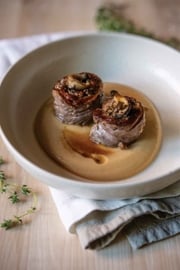Candied Walnut and Sprouted Buckwheat Salad with Apple Vinaigrette

Sprouted buckwheat is a complete protein, containing all the essential amino acids. It’s high in iron and calcium, which help prevent osteoporosis, and lecithin, which fights cholesterol and helps cleanse the lymphatic system. When sprouted, the grain softens but retains a nutty flavour.
1/2 cup (125 mL) walnut pieces
2 Tbsp (30 mL) maple syrup or agave nectar
1/4 tsp (1 mL) salt
1/2 cup (125 mL) sprouted buckwheat
1 cup (250 mL) diced bell pepper (red, orange, green, or a combination)
2 cups (500 mL) baby spinach
1/2 cup (125 mL) apple juice
1 shallot, peeled and thinly sliced
2 garlic cloves, minced
5 tsp (25 mL) apple cider vinegar
1/4 tsp (1 mL) salt
1/4 tsp (1 mL) freshly ground pepper
2 tsp (10 mL) extra-virgin olive or walnut oil
Preheat oven to 350 F (180 C).
Combine walnut pieces with maple syrup and salt and place in a single layer on parchment-lined baking sheet. Bake for 15 minutes. Remove from oven and stir. Remove parchment paper from baking sheet and let cool about 30 minutes, stirring occasionally.
In large bowl combine sprouted buckwheat with bell pepper and baby spinach.
In small saucepan combine apple juice, shallot, and garlic. Bring to a boil, reduce heat to medium-low and simmer until liquid is reduced by half, about 10 minutes. Remove from heat and whisk in apple cider vinegar, salt, and pepper. Slowly drizzle in olive or walnut oil, whisking constantly. Pour over sprouted buckwheat. Top with candied walnuts and toss to combine.
Serves 4.
Each serving contains: 254 calories; 6 g protein; 13 g total fat (1 g sat. fat, 0 g trans fat); 32 g total carbohydrates (11 g sugar, 4 g fibre); 308 mg sodium
Vitamin support for athletes
As an active person, you may require additional levels of certain vitamins and minerals to support your training, specifically iron; B vitamins; vitamins A, C, E, and D; and calcium. Fill your nutritional gap with this Candied Walnut and Sprouted Buckwheat Salad, which boasts vitamins A- and C-rich spinach, calcium-concentrated walnuts, and buckwheat, which is loaded with B vitamins and iron.
Tip
You can soak walnuts to make them more digestible by placing them in a bowl with 3 cups (750 mL) filtered water for 8 hours, draining the bowl, and then dehydrating the walnuts in a dehydrator set to 95 F (35 C) for 6 to 8 hours. Turn them after 3 to 4 hours.
You can also dehydrate them in an oven set to the lowest temperature with the door slightly ajar, turning them occasionally, for 3 to 4 hours. Let them cool to room temperature and transfer to the fridge until ready for use, up to 1 week. They will keep several months in the freezer.
source: "Sprouting Out All Over", alive #359, September 2012





